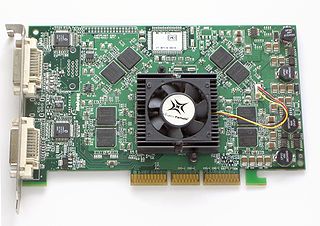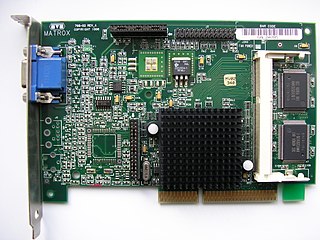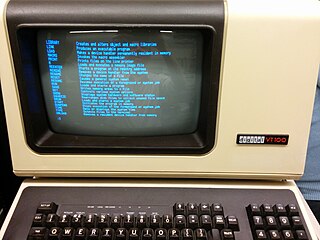In computing, Common Gateway Interface (CGI) offers a standard protocol for web servers to execute programs that execute like console applications running on a server that generates web pages dynamically. Such programs are known as CGI scripts or simply as CGIs. The specifics of how the script is executed by the server are determined by the server. In the common case, a CGI script executes at the time a request is made and generates HTML.

Matrox is a producer of video card components and equipment for personal computers. Based in Dorval, Quebec, Canada it was founded by Lorne Trottier and Branko Matić. Matrox is an umbrella name for two legal entities:

In computing, dir (directory) is a command used for computer file and directory listing.
X3D is a royalty-free ISO/IEC standard for declaratively representing 3D computer graphics. File format support includes XML, ClassicVRML, Compressed Binary Encoding (CBE) and a draft JSON encoding. It became the successor to the Virtual Reality Modeling Language (VRML) in 2001. X3D features extensions to VRML, the ability to encode the scene using an XML syntax as well as the Open Inventor-like syntax of VRML97, or binary formatting, and enhanced application programming interfaces (APIs).

Lunar Linux is an operating system maintained around a source-based package management system also called Lunar. The project is a descendant of the Sorcerer Linux distribution.

Fast Light Toolkit is a cross-platform widget library for graphical user interfaces (GUIs), developed by Bill Spitzak and others. Made to accommodate 3D graphics programming, it has an interface to OpenGL, but it is also suitable for general GUI programming.

The MPU-401, where MPU stands for MIDI Processing Unit, is an important but now obsolete interface for connecting MIDI-equipped electronic music hardware to personal computers. It was designed by Roland Corporation, which also co-authored the MIDI standard.
Rendition was a maker of 3D computer graphics chipsets in the mid to late 1990s. They were known for products such as the Vérité 1000 and Vérité 2x00 and for being one of the first 3D chipset makers to directly work with Quake developer John Carmack to make a hardware-accelerated version of the game (vQuake). Rendition's major competitor at the time was 3Dfx. Their proprietary rendering APIs were Speedy3D and RRedline.

Intellivision Lives! is a compilation of over 60 Intellivision video games, originally produced by Mattel Electronics and INTV Corporation between 1978 and 1990. Using original game code and software emulation, Intellivision Productions released the first edition in 1998 on a Windows and Macintosh hybrid CD-ROM. A sequel, Intellivision Rocks, was released in 2001 that includes third-party games originally published by Activision and Imagic as well as Mattel Electronics Intellivoice and ECS games. Versions of Intellivision Lives! were then released for the PlayStation 2, Xbox, and Nintendo GameCube by Crave Entertainment. In 2010 Virtual Play Games released a Nintendo DS edition.
In computing, SUBST is a command on the DOS, IBM OS/2, Microsoft Windows and ReactOS operating systems used for substituting paths on physical and logical drives as virtual drives.

Matrox Parhelia-512 is a GPU with full support for DirectX 8.1 and incorporating several DirectX 9.0 features. Released in 2002, it was best known for its ability to drive three monitors and its Coral Reef tech demo.
The G400 is a video card made by Matrox, released in September 1999. The graphics processor contains a 2D GUI, video, and Direct3D 6.0 3D accelerator. Codenamed "Toucan", it was a more powerful and refined version of its predecessor, the G200.

The G200 is a 2D, 3D, and video accelerator chip for personal computers designed by Matrox. It was released in 1998.
The Mystique and Mystique 220 were 2D, 3D, and video accelerator cards for personal computers designed by Matrox, using the VGA connector. The original Mystique was introduced in 1996, with the slightly upgraded Mystique 220 having been released in 1997.

In computing, the print command was introduced in MS-DOS/IBM PC DOS 2.0 in order to provide single-user print spooling capability. It is roughly similar to that provided by the UNIX System V lp and BSD lpr print spooler systems. The command is also available in the DEC RT-11, OS/8 and TOPS-20 operating systems and also in FlexOS, PTS-DOS, Microsoft Windows, FreeDOS, OpenVOS, AROS, and MPE/iX.
The following table compares the operating system support and basic features of various UPnP AV media servers.
Nvidia Ion is a product line of Nvidia corporation intended for motherboards of low-cost portable computers. It uses graphics processing units and chipsets intended for small products.
SWORD is an interoperability standard that allows digital repositories to accept the deposit of content from multiple sources in different formats via a standardized protocol. In the same way that the HTTP protocol allows any web browser to talk to any web server, so SWORD allows clients to talk to repository servers. SWORD is a profile (specialism) of the Atom Publishing Protocol, but restricts itself solely to the scope of depositing resources into scholarly systems.
This page is based on this
Wikipedia article Text is available under the
CC BY-SA 4.0 license; additional terms may apply.
Images, videos and audio are available under their respective licenses.










